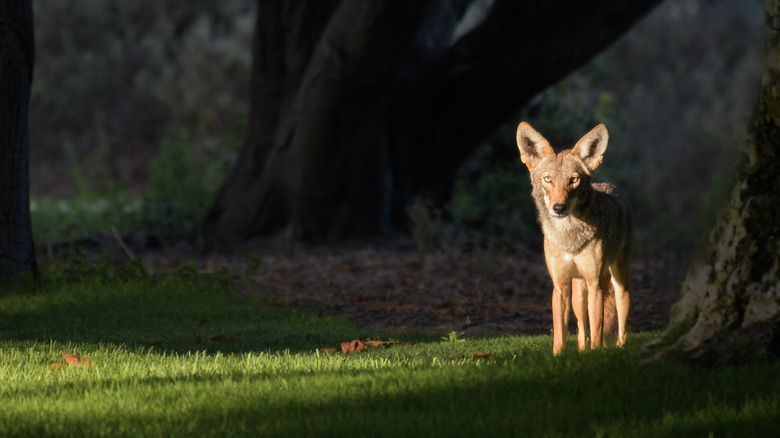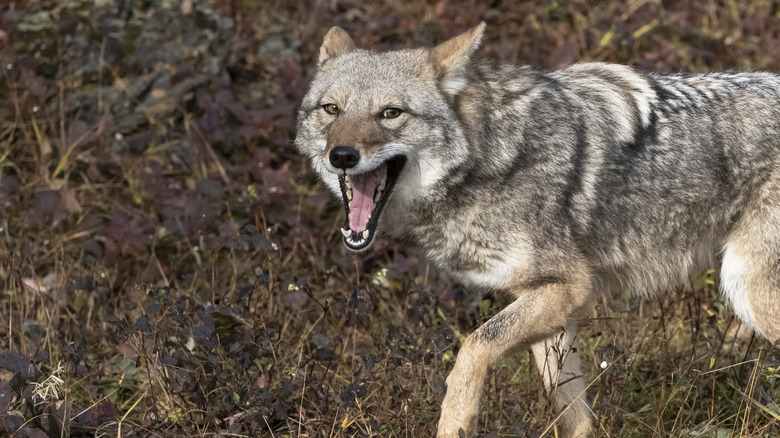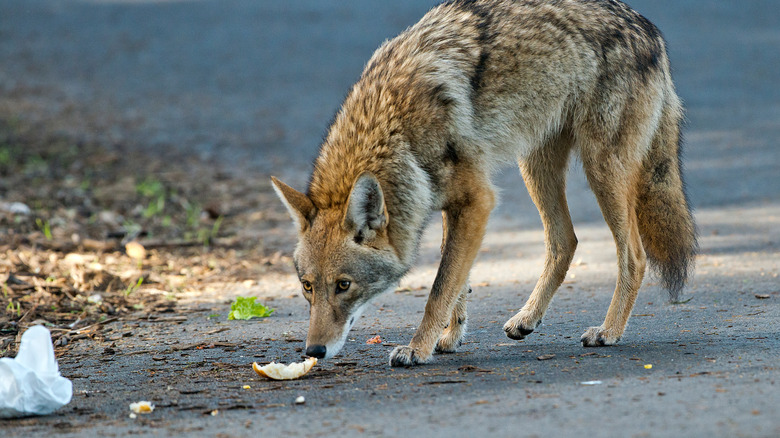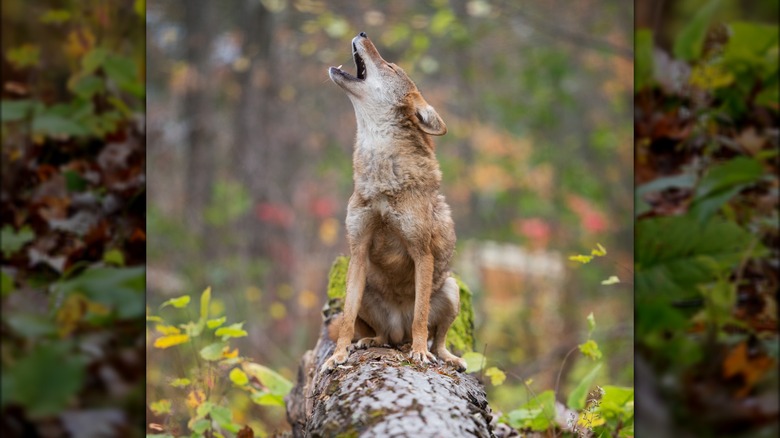If You Ever Come Across A Coyote, Here's What To Do
You may hear their howls at night. You may see their shadow, loping around the streets at sunset. Coyotes are everywhere. Whether you're spending your time hiking in Colorado, camping in Texas, lying on a Florida beach, trekking in Alaska, or walking around New York City, coyotes may be there. They have been spotted in rural, suburban, and urban environments in every U.S. state except Hawaii.
These fascinating and resourceful creatures are here to stay, so we have to learn how to live alongside them. Our behavior is reflected back at us in the behavior of our local coyote population. When people interact with them in the wrong ways, either by feeding them, accidentally attracting them, or being too fearful of them, the coyotes start behaving in ways that can put them in danger or make them more likely to bite humans or domestic animals. In order to keep the coyotes, our pets, and ourselves safe, we should treat them cautiously, give them space, and ensure they do not become too comfortable around humans for their own good.
What to do if you see a coyote
Coyotes should be shy animals that hide from people, and generally, if you see a coyote, you can leave it alone. However, if humans interact with them too much or if they come to associate humans with food, they can lose their fear. If the coyote is acting unusually bold and unafraid of you or other humans nearby, you will need to scare it away.
As described by The Humane Society, coyotes that are habituated to humans will not run away. This is dangerous for coyotes, pets, and humans, especially children. A process called hazing is used to get coyotes out of populated areas and help keep them wild. Your first move should be to wave your hands over your head and shout. If it doesn't leave or runs a short distance and then looks back, you should approach, continuing to shout. If it still does not leave, you may need to stomp, spray it with water, or toss something harmless, like a stick, in its direction. Hazing a coyote may seem mean, but teaching them that humans are safe to approach and interact with is worse.
It is also vital that you do not run away from a coyote, as doing so makes you seem like a prey animal, giving coyotes the mistaken impression that they should not fear, or even chase after, people.
How to respond to coyotes who act in different ways
In order to coexist peacefully with coyotes, humans have to interact with them in a safe way. If it is too late and the coyotes have already developed dangerous habits, people need to change their behavior towards them accordingly. As described by the Urban Coyote Research Project, if coyotes are only occasionally seen at night, then there is no reason for concern and you should leave the coyote alone. All you need to do is make sure your pets are indoors and you aren't leaving food out that will attract the coyotes to your neighborhood. If you are seeing coyotes often, and sometimes even in the day, you should haze the coyotes you see and chase them off so they stop associating humans with food.
If you're seeing coyotes regularly during the day and they have started stalking domestic animals it is time to be concerned. Authorities may need to consider local education programs to stop humans from feeding the coyotes. If coyotes are chasing after people, attacking pets, and don't run away when you shout at them, your local authorities will probably need to begin a removal program. You can help avoid these extreme measures by hazing coyotes before they become too comfortable around people.
Keep your pets inside
Coyotes aren't much of a threat to adult humans unless they have rabies, but they can be deadly for pets. If you're seeing or hearing coyotes in your area, you should not let your pets outside unsupervised, especially at night. This is especially true for cats, which can be easily eaten by a coyote (or an owl, fox, bobcat, or dog.) Small dogs loose in backyards may also be at risk, if coyotes in the area are bold enough to get that close to human homes.
Larger dogs aren't likely to be hunted, but they can still get into fights with coyotes, especially in the spring when coyotes are building their dens. During this time, coyotes are especially territorial because they are looking to build safe homes for their pups. If they spot your dog, they may view them as a threat. If your dog also sees the area as its territory, they may fight.



